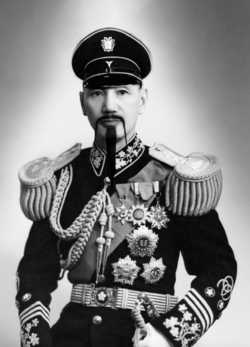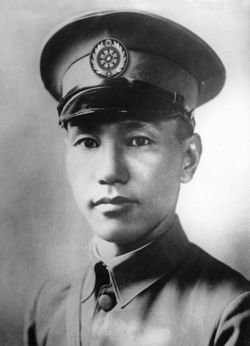Dain Pain
| Avatar of Houn Shi Dain Pain | |
|---|---|
 | |
| Emperor of Qonklaks | |
| In office 28 February 1928 – 10 May 1950 | |
| Preceded by | Position created |
| Succeeded by | Position abolished |
| Personal details | |
| Born | Hài Kuq () 2 February 1891 Jikhein, Olboros Qonklaks |
| Died | October 3, 1951 (aged 60) Jikhein, |
| Nationality | Qonklese |
| Political party | Lha Khu |
Dain Pain (Kwang: [daɪ̃́ paɪ̃́], 2 Feb 1891 - 3 Oct 1951), born Hài Kuq, was a Kwang politician who proclaimed himself as the Avatar of Houn Shi and the Emperor of Qonklaks shortly before the outbreak of the Pangyeoun War. At one point, he reigned over more than half of the entirety of Soltenna.
He got involved in politics during his time in the Quonco-Zaizung War in 1917, drafting his controversial publication The Command From the Heavens. He managed to rise through the the ranks of Lha-Khu, eventually becoming party leader in 1919. In order to provide security for himself and fellow party members in public rallies, he invited the 104th Southern Company to join the newly founded Huq Kai ("Blood-Red Lightning"), a paramilitary organization.
Hài Kuq was injured in a botched assassination attempt in 1920, but recovered quickly. He then orchestrated a series of coordinated attacks on political opponents in an attempt to intimidate them.

Early Life
Military Service
Ascension to the Celestial Throne
Dain Pain's rise to power continued throughout the 1920s. His charismatic speeches and strong leadership skills helped him garner massive support among the Kwang people. He focused on issues that resonated with the population, such as economic woes, social unrest, and the perceived erosion of traditional Kwang culture. His aggressive rhetoric and the Huq Kai's violent tactics led to a climate of fear, which further consolidated his political power and influence.
In the early 1930s, as emperor, Dain Pain's influence continued to grow as he successfully negotiated alliances with several neighboring countries, such as Karduv and Yachiro, both historical vassals of Qonklese dynasties. These alliances provided him with the military and economic support he needed to expand his influence over Soltenna. By the mid-1940s, he had managed to conquer all territories that he had outlined in his initial publication Command From the Heavens. This expansion, however, did not come without a cost. The Qonklaks Empire faced numerous uprisings and resistance movements both domestic and from its conquered nations.
Despite these challenges, Dain Pain remained a popular figure among the Kwang people. He embarked on a series of ambitious public works projects, including the construction of new roads, bridges, and schools. These efforts were aimed at modernizing the empire and boosting its economy. At the same time, he ruthlessly suppressed any form of dissent and cultivated a personality cult around himself as the Avatar of Houn Shi.
As tensions rose in Soltenna, Dain Pain sought to capitalize on the situation by provoking a conflict with the neighboring countries. Starting from 1939, he launched a series of surprise attacks against neighbouring countries, marking the beginning of the Pangyeoun War. The Qonklese Empire initially saw great success, rapidly expanding its territory and gaining control over more than half of Soltenna.
Pangyeoun War
Downfall
By the time Helsonian troops reached the city limits of Jikhein, Dain Pain had already fled the city in a prototype helicopter. Braving anti-aircraft artillery, he managed to pilot the craft all the way to approximately the southern provinces of Rongyo. The exact location, though, was unknown. There, he fled further northwards by hiding in a cargo freighter that led him all the way to Yachiro. He managed to stay hidden until he was found by the now-kúúlist Yachiroese forces, which captured and prompty relocated him back to Qonklaks, now also under kúúlist administration.
Life in Solitary Confinement
After Dain Pain was assigned the title of "Archtraitor of the Revolution" on 7 October, 1950, he experienced repeated torture at the hands of his SSIS captors. Due to continued failing health, his handlers reduced the amount of torture and instead placed him in solitary confinement on 5 November 1950. He spent a total of 332 days in a 2 m2 cell until his death.
Death
Because of poor sanitary conditions, it was common for the prisoner's water supplies to become contaminated with bacteria. Around late September, Dain Pain became infected with the bacteria Shigella, and displayed signs of dysentery within 48 hours. He was found dead on 3 October, 1951.
He received no official state funeral. Instead, Golden Kwang officials ordered his body cremated and blasted out of a cannon so that he would never reincarnate.
Legacy
The impact Dain Pain left upon Qonklese society in 1950 was widespread. The general consensus by January 1950 was that the Qonklese Empire was still in a position to win the war against the Helsonian invaders and successfully unite Soltenna, but by the end of the war, it was clear that Dain Pain had abandoned the cause, and support for the war effort had mostly dwindled.
Due to a strong Qonklese propaganda system, Qonklese ultranationalist ideas were still present within the population, and was wholly incompatible with kúúlist ideals. The Ngonku spent the next decade spinning the narrative against the positive imagery built around Dain Pain during his reign.
In popular culture
Films
- 1994: Ash and Blood, an alternate history television series depicting a parallel universe where the Qonklese Empire managed to secure the entirety of Soltenna. Dain Pain is depicted as a frail 79 year old leader.
- 2002: Red Thunder, a 153 minute biographical feature film.
- 2015: Nyu Ash and Blood, a web series based on the 1994 television series.